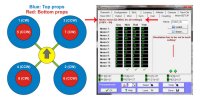Some month ago I was running different props at top and bottom and I argumented that with the "already accelerated air" the second prop runs into. For now I am using the same size at top and bottom, since (if you think twice) the "massflow" through the two props is the same, since (in the range we are dealing with it) air is incompressible. So you cannot see the two props independent, or the second working "after" the first, the are working "together". Also the radial-speed of the airflow is of minor order, and if you run the lower prop at same rpm but higher pitch, this additional massflow must enter the second prop beside the airflow through the first prop.
In my practical tests, I could only get less efficiency on the prop (significant). On the other hand, if you compare a flat okto with an X8 you can build a much lighter frame for an X8 which of course increases the efficiency of the whole copter. So there is no winner, if you go for records (in flight-time) I think a flat-setup is superior to a coax-setup, but for "standard" applications the coax plays it´s advantages, you have have much smaller frames, bigger props (X8 compared to Flat Octo), and your frame has typically less weight. The coax is considerably more stable (e.g. if a fast descent, or in windy conditions).
Until now I have tried the following combinations:
12x3,8 and 11x5
11x5 and 11x5
14x8 and 14x8
14x7 and 14x8
15x4 and 14x7
17x5,5 and 17x5,5 (top secret for now

)
Here some of my coax setups:
best regards
Ferdinand

